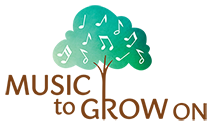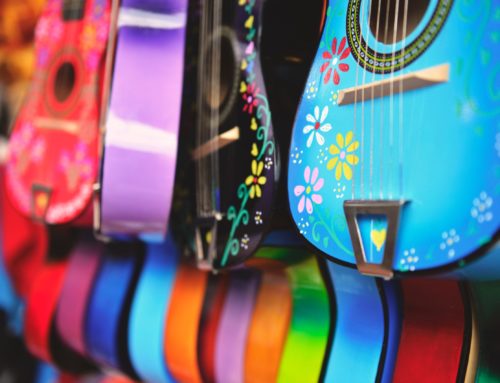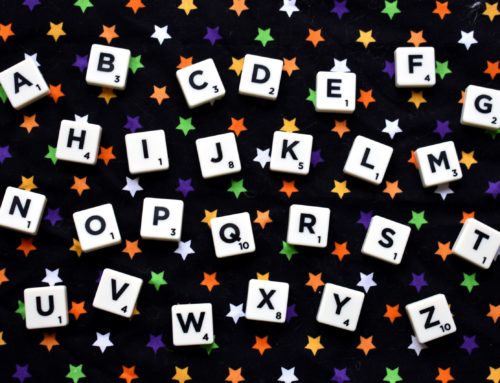Homemade instruments, ravioli, and marching dinosaurs, oh my!
Making music with your little ones can be fun, easy, and spontaneous! Chances are, you may already be engaging your child in musical experiences, whether that be in singing a sweet lullaby to them before they go down for a nap, bouncing them on your lap in rhythm to a catchy tune, or making up little songs as you go about your day. Moreover, research has shown that engaging in music from an early age has been linked to increases in a number of areas, such as:
- social-emotional skills,
- gross and fine motor skills,
- language development,
- pre-academic skills,
- and focus and attention skills.
This study conducted by Dr. Dennie Palmer Wolf in partnership with Carnegie Hall’s Weill Music Institute provides a thorough yet easy-to-read breakdown of the many ways that music positively impacts young children’s lives (the below graphic lists the main categories covered in the study).
If you’re looking for more ways to expand your musical repertoire with your little ones, look no further! In this first of two posts about early childhood music, I’m excited to share with you a variety of movement based songs and musical activities using instruments easily made from household objects. Stay tuned for the next post in the weeks to come where I will discuss how you can incorporate your child’s toys into songs as well as share some of my favorite finger play songs. In the comments section at the very end of this post, let me know what some of your favorite songs are to use with your little ones!
Homemade Instruments
Finding things that make noise in your home shouldn’t be tricky. If you need a little inspiration, my coworker, Kaitlyn, created a musical scavenger hunt in her blog post which has some great ideas for finding things that make all kinds of sounds. Additionally, here is an article which also lists some awesome ways to make fun instruments at home such such as a cereal box guitar, “pin strummers” made from bobby pins, and mini cymbals made from old CD’s you may have lying around. Some of my favorite homemade instruments which I’ve made quickly and easily include Tupperware drums, plastic spoon and egg maracas, toilet paper roll shakers, and a tissue box guitar. Long slender objects such as writing utensils, chopsticks, and spatulas can function as drum or rhythm sticks in a pinch. Below are a few activities you and your child can do with these homemade instruments.
Shakers
- Stop & Go: This activity is great for increasing auditory and visual attention to task. It can be done with any recorded song or by singing one of your favorite songs with your child. Play the recording or begin singing and shaking while encouraging your child to shake along too. Stop singing or pause the recording at the end of a phrase while shouting, “Freeze!” and see if your child can follow along by freezing in place. Here is one of my favorite tunes to use with young children.
- Do As I’m Doing: This song is great for increasing your child’s gross motor movement and their ability to follow simple directions. Without instruments, you and your child can follow along with the video and perform the same movements as directed. If you’d like to incorporate instruments such as shakers, you can use this same melody and tweak the lyrics slightly to encourage your child to play their shakers in a specific way (such as up high, down low, side to side, etc.) or even on a specific body part (such as on your head, shoulders, nose, toes, etc.). Below is an example of lyrics you can use:
Do as I’m doing, follow follow me,
Do as I’m doing, follow follow me!
I can shake them way up high, or I can shake them on my nose,
Can you shake yours way up high? or Can you shake them on your nose?
Do as I’m doing, follow follow me,
Do as I’m doing, follow follow me!
Drums
- We Are the Dinosaurs: This song by The Laurie Berkner Band has become one of my favorite drum songs to work on increasing children’s gross and fine motor skills. (As a really quick side note, Laurie Berkner is one of the most popular children’s artists out there today, and for good reason. Her catchy tunes are well-loved by parents and children alike and cover a wide range of topics and activities for both younger and older children, many of which are easily accessible here on her YouTube channel. I definitely recommend her to anyone looking for some great songs for their little ones!) I’m including the full lyrics here for reference and will highlight just a few lines from the song to pair them with the drum actions that I typically use.
We are the dinosaurs marching, marching… [begin drumming by alternating your right and left hands in a steady beat; continue drumming in this way until you reach the next line]
We make the earth flat, we make the earth flat [here you can use both hands and rub them back and forth on top of your drum repeatedly]
We stop and eat our food, when we’re in the mood… [you can model eating on the drum by wiggling all your fingers, as if you were typing lots of random letters on a keyboard, all around the drum during this entire verse; you can even wiggle your fingers to tickle your child if they enjoy that!]
We stop and take a rest over in our nest… [here you can slow down your drumming and even pause to pretend you’re taking a nap]
And then we ROOOOAR! [if your child loves to roar like a dinosaur and play the drums really fast, then they’ll love this part!]
- The Ants Go Marching: I also love using this tune to work on increasing direction following skills and counting skills. Depending on the ability of the child, I may focus more on counting, but you can vary it up as you’d like. Below are the lyrics for the main verse and my recommendations for what actions you can perform when singing numbers 1-5.
The ants go marching one by one, hurrah, hurrah
The ants go marching one by one, hurrah, hurrah
The ants go marching one by one, the little one stops to [insert direction]
And they all go marching down, to the ground, to get out of the rain
Boom boom boom boom boom!
If you’re focusing on counting throughout the song, you could encourage your child to play x number of times and model that for them. For example, for the first verse where the ants go marching “one by one,” you can emphasize hitting the drum one time and encourage your child to do the same. When singing “two by two,” model hitting the drum two times, for “three by three,” model hitting it three times, etc.
If you’d like to focus instead on imitating other actions, here’s what I do for each of the verses: for “one by one,” I sing the direction, “play on the drum.” For “two by two,” I sing, “play on your shoe.” For “three by three,” I sing, “play on your knee.” For “four by four,” I sing “knock on the door” and model a knocking motion on the drum. Finally, for “five by five,” I like to sing the direction, “give a high five” and encourage the child to give me a high five. Ultimately, it’s up to you to choose which actions you’d like to model for your child, and of course, the beauty of this and any of these songs I’m presenting is that you can be as creative as you’d like and come up with any of your own lyric and direction substitutions!
Rhythm sticks
- Stick Tune: This song by Music Together is one of my go-to’s when using rhythm sticks. It’s a great activity for increasing your child’s bilateral coordination, or the ability of your child to use both sides of their body simultaneously. I use the basic melody and tweak the lyrics just a bit to sing, “Hey hey, whaddya say, let’s all tap our sticks this way, ba dum, dum dum dum dum,” while modeling various ways to tap the two sticks together. Some examples of different things you can do with your rhythm sticks include: tapping them in a letter T shape, rubbing them back and forth, rolling them on the ground, tapping the ends together, holding them while rolling your hands in the air (akin to the same movement performed during the song, “Wheels on the Bus”), and tapping them on various body parts. Depending on the action, you can also incorporate a verbal direction into the song. For example, you might sing, “Hey hey, whaddya say, let’s all roll our sticks this way,” or “let’s all play our sticks up high,” or “let’s all play our sticks on our bellies,” etc. Providing the verbal directive paired with the visual stimulus of you modeling the targeted action can help your child follow the direction better.
- Tap Your Sticks: Here’s a song by Hap Palmer which is easy for you and your child to follow along with. In addition, you can sing the melody yourself and tweak the lyrics to include even more actions such as playing on various body parts, or even slowing down or speeding up the song.
Movement Songs
You put your left hand in, you put your left hand out
You put your left hand in and you shake it all about!
Did you start singing the “Hokey Pokey” in your head as soon as you read that? A popular campfire song, it’s hard to resist getting up and dancing with this catchy tune, and it’s one of many that I’d like to highlight and encourage you to use with your little ones. Engaging in movement based activities with children from an early age helps to increase their gross and fine motor skills (those involving large versus small muscle movements), as well as their attention and direction following skills. Below are just a few of my favorite movement songs; I’d love to hear about any of your favorites if you’d like to leave a comment at the end of this post!
“The Goldfish (Let’s Go Swimming)” – The Laurie Berkner Band
Laurie Berkner gets a second mention in this post simply because she has so many awesome songs! This one in particular is a song about some fish who want to do some very silly things until they remember—hey wait a minute!—that they’re fish, so let’s go swimming! You and your toddler can join in with the band as they take showers, ride their bikes, and brush their teeth.
“Ravioli” – traditional campfire song
And another popular campfire song makes the list! This simple tune is excellent for working on gross motor movements, body part identification, and even vocalizing the long “o” vowel sound. When singing the beginning lyrics, “Ravioli, I like ravioli / ravioli, it’s so good for me,” you can encourage your child to clap their hands, pat their knees, or any kind of similar movement in rhythm. As you name various parts of the body (e.g., “Do I have it in my hair? / Yes I have it in my hair / In my hair, in my hair, ohhhhh nooooo!”), tap that part of your body; when you get to the “oh no” part, you can cup your hands around your mouth and enunciate each word clearly so that your little one can attempt to copy you. You can add in as few or as many body parts as you wish, and you could even throw in types of clothes such as shirt, shoes, pants, etc. to add some more variety. I typically like to end the song with a verse about ravioli being in my tummy, that way I can end by rubbing my belly and saying, “Yum yum yum yum yum!”
“Brush Your Teeth” – Raffi
From beloved Canadian singer-songwriter, Raffi, comes a perfect song for reinforcing a basic life skill that we all have to do. You and your child can follow along with Raffi in every verse as he mimics brushing his teeth, a fine motor movement as it targets small finger muscles to move up and down. (As another quick side note, I’m going to link Raffi’s YouTube channel here as he also has a great variety of children’s songs.)
Concluding Thoughts
Well we’ve reached the end of part one of early childhood music making, and I hope you’ve discovered some new and creative ways to make music easily with your little ones. Be on the lookout for part two which should be coming in the next few weeks or so, and in the meantime, I would love to hear about some of your favorite songs or musical activities that you’ve used with your children in the comments section below. Finally, I want to emphasize that the opportunities for making music are endless; whether that be in engaging with your child in a little impromptu drum session on their pillow, to soothing them to sleep with their favorite lullaby, to making up a tune about all the cars passing by your window—the list could go on and on! Your child will doubtless enjoy any kind of musical engagement with you, and that in turn, will only help to develop their mind, body, and soul in so many lasting, positive ways.







Leave A Comment